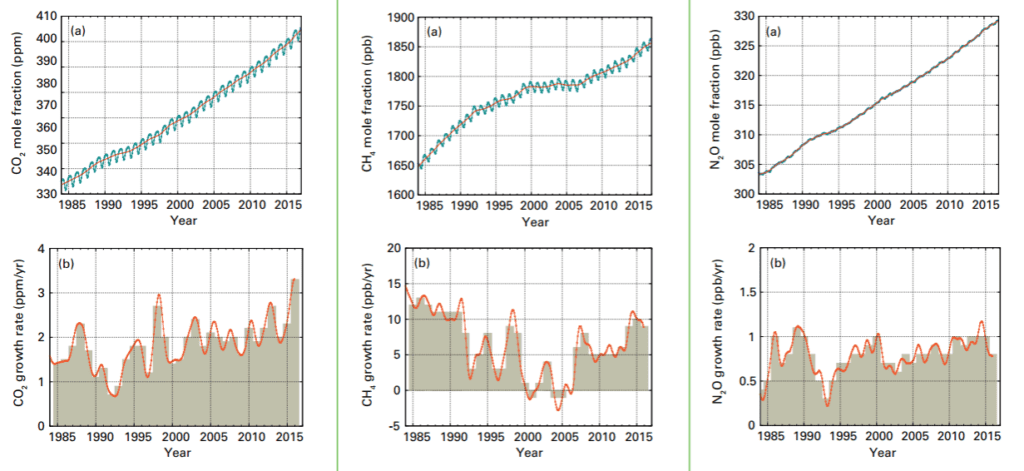Atmospheric CO2 levels reached a record high in 2016– the highest the Earth has seen over in the last 3 million years. More worryingly, the World Meteorological Organization (WMO, part of the UN) reports that last year’s increase was 50% higher than the average over the last 10 years, and points to the appearance of a wildcard that could shatter the temperature goals set in Paris.
Researchers say that several factors, most notably human activity and the 2016 El Niño, powered the surge.

Looking for a seriously spooky costume idea this Halloween? The WMO’s latest Gas Bulletin might be just what you need. The document is produced each year by the WMO using data recorded by research stations in 51 countries. These measure concentrations of greenhouse gases such as carbon dioxide, methane, and nitrous oxide after the planet’s sinks (such as the biosphere or oceans) scrubbed all they could of these gasses from the atmosphere — so the WMO’s report doesn’t show the sum of gases pumped into the atmosphere, only what’s beyond the Earth’s ability to clean up.
CO2
It doesn’t look pretty. Overall, the document reports, in 2016, atmospheric concentrations of CO2 hit 403.3 parts per million (ppm), up from 400ppm in 2015.
“It is the largest increase we have ever seen in the 30 years we have had this network,” Dr Oksana Tarasova, chief of WMO’s global atmosphere watch programme, told BBC news.
“The largest increase was in the previous El Niño, in 1997-1998, and it was 2.7ppm; and now it is 3.3ppm. It is also 50% higher than the average of the last 10 years.”
El Niño phenomena can impact carbon levels in the atmosphere by causing droughts over wide areas, stifling plant growth and thus limiting their ability to absorb CO2.
There is a piece of good news in the report: human emissions have slowed down in the last couple of years. However, Dr. Tarasova warns that it’s not simply new emissions but rather the total levels in the atmosphere that matter; CO2 can remain airborne and active as a greenhouse gas for centuries. Over the last 70 years, the report notes, carbon dioxide levels in the atmosphere have started increasing 100 times faster than at the end of the last ice age due to population growth, intensive agriculture, deforestation, and industrialization. Overall, CO2 concentrations have more than doubled since that baseline.

We’re already seeing the effects of this build-up. Since 1990, scientists have recorded a 40% increase in total radiative forcing — the difference between how much energy the Earth receives and how much it vents out. The higher the total radiative forcing gets, the more energy stays on Earth in the form of heat. Greenhouse gasses drive radiative forcing up by preventing energy in the atmosphere from radiating to outer space.
It’s a huge rise in concentration in what, geologically speaking, is an extremely short span of time — “like an injection of a huge amount of heat,” according to Dr. Tarasova.
“The changes will not take 10,000 years, like they used to take before; they will happen fast. We don’t have the knowledge of the system in this state; that is a bit worrisome!”
The last time our planet harbored similar CO2 concentrations was in the mid-Pliocene, a geological epoch spanning from three to five million years ago. The climate was 2 to 3 °C (3.6 to 5.4 °F) warmer back then, and sea levels were 10 to 20 m (32.8 to 65.6 ft) higher than today, pushed up by meltwater from the Greenland and West Antarctic ice sheets.
Methane
One more worrying trend seen by the WMO is a currently-unexplained increase of atmospheric methane, also larger than the average over the past decade. Growth was strongest in the tropics and subtropics, and carbon isotope analysis has revealed the growth is not released by burning fossil fuels; it’s not clear where it is coming from. The worst-case scenario, researchers fear, is that we’re looking at the start of a feedback mechanism.

Methane is a much more powerful greenhouse gas than CO2, but it’s also less chemically stable, so it breaks down faster. A climate-driven, methane-based feedback mechanism, however, has the potential to drive up temperatures astoundingly fast. Such an event starts with methane from decaying biomass being generated much faster and in larger quantities than usual since we’re making it warmer. That methane will, in turn, raise average temperatures, which starts the loop again and generates even more methane before it can fully break down in the atmosphere.
It’s a particularly troubling find since the Paris Agreement didn’t foresee such an increase in methane levels — in effect, it’s a wildcard that could throw a major wrench in our plans. Overall, the WMO says, their new report doesn’t bode well at all for the targets governments around the world set in Paris.
“The numbers don’t lie. We are still emitting far too much and this needs to be reversed,” said Erik Solheim, head of UN Environment.
“We have many of the solutions already to address this challenge. What we need now is global political will and a new sense of urgency.”
WMO released the report a week in advance of the UN climate talks, to be held in Bonn. The authors urge policymakers to step up countermeasures to reduce the risk of global warming exceeding the Paris climate target of between 1.5C and 2C. The talks will carry on despite the US’ intended withdrawal from the Paris Agreement.
The WMO predicted 2017 will again break records for concentrations of CO2 and methane, but with lower growth rates because since is no El Niño effect.


